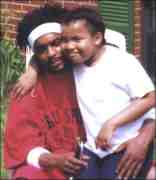Police Brutality Haunts Cincinnati Years After Riot
May 19 (Bloomberg) --

Cincinnati police stopped Roger Owensby Jr. outside a convenience store on Nov. 7, 2000. Thirty minutes later, the Gulf War veteran, 29, was dead, a victim of homicide by ``police intervention,'' the coroner ruled.
His family would later complain that Owensby, who was black, was tackled by two white officers, handcuffed, subdued with pepper spray, beaten, and left without medical attention.
As the City of Cincinnati tries to close the book on the Owensby case and similar incidents that sparked rioting five years ago, community leaders report lingering mistrust. The city settled the Owensby family's lawsuit last month for $6.5 million, ending the last in a series of lawsuits alleging violent treatment of blacks.
City officials say the police department's interactions with black residents have improved significantly. Critics say more needs to be done.
``You don't have as many shootings, but the black community still doesn't feel it's being treated fairly,'' said Iris Roley, 42, vice president of Cincinnati Black United Front and a community organizer for the American Civil Liberties Union.
The claims of mistreatment and a federal investigation led city officials to agree in 2002 to improve police procedures and training and to accept U.S. Justice Department oversight of those changes until 2007.
Cincinnati has been trying to turn perceptions of police abuse around, City Solicitor Rita McNeil said. ``We may not be where we want to be, but we're closer.''
Over the past several years, Owensby's death was often cited by city residents as proof that even middle-class blacks weren't safe. The two officers were tried for assault and acquitted.
Class-Action Suit
``He was a perfectly respectable young man,'' said the Owensby family's attorney, Jim Helmer. ``This could have happened to anybody.''
Cincinnati lawyer Alphonse Gerhardstein, who filed a civil rights class action against the city that alleged racial profiling and police mistreatment of citizens, recalled that the city was at ``a low ebb.''
``There was nothing on the horizon that would show an African-American citizen that they were being treated fairly,'' he said.
In April 2001, five months after Owensby died, Timothy Thomas, 18, was shot and killed while running from the police, igniting three days of civil unrest in the city, Helmer said.
``After Owensby and Thomas, the community had had enough,'' he said.
Roley said racial profiling was common and, for black residents, often frightening. Seven years ago, her son, then 17, was walking home with his brother, 7, when they were stopped by police, she said.
`Gun to His Head'
The police pulled the older boy over, saying he was a robbery suspect, she said. ``They put him on the ground with a gun to his head. They let him go, but no one ever said they were sorry.''
Cincinnati, a southern Ohio city of about 300,000 people is about 43 percent black, according to U.S. census figures. About 32 percent of its 1,084-person police force is black, up from about 29 percent in 2001.
A month after that year's riot, the U.S. Justice Department began investigating the Cincinnati police. This led to the city's settlement with federal officials, where it agreed to revise policies on the use of force, and a settlement of the racial profiling lawsuit, under which the city established a police-community partnership to increase communication.
An independent monitor tracks the city's progress for both agreements, said S. Gregory Baker, the city's compliance officer for the settlements.
Choke Holds Barred
The police department prohibited choke holds, increased the use of electric stun guns called Tasers, and required annual use-of-force training for all officers, according to the most recent report of the monitor, Saul Green, a former U.S. attorney in Detroit.
``There are significantly fewer injuries in incidents between police and citizens,'' said Richard Biehl, 53, executive director of the Community Police Partnering Center, which was established after the agreement with the Justice Department to change police-community relations.
Injuries to suspects and prisoners in police custody declined by 24 percent from 2004 to 2005, Baker said. There were no deaths in custody in 2004 or 2005, he said. There were two deaths in 2000 and one in 2001, and the city doesn't have comparable figures on injuries in previous years, Baker said.
While there are fewer serious injuries, the black community still believes it is being targeted by city police, Roley said. ``Instead of guns, they're using Tasers,'' she said.
`Neighborhood Level'
Biehl, who was an assistant police chief in Cincinnati when Owensby and Thomas died, said the department's processes have changed.
``But members of the community haven't seen significant changes at the neighborhood level,'' he said. ``Additional efforts are clearly important.''
The Owensby settlement should help improve community perceptions of the police, City Solicitor McNeil said.
The city previously paid $4.5 million to settle several other individual claims, including one filed by the Thomas family. The Owensby settlement is the last of the lawsuits arising from this period, McNeil said. ``We think this closes the wounds.''
The city healed the wound to the Owensby family reluctantly, Helmer said.
``The city had taken 12 appeals and lost every one,'' he said. ``The city was in the process of taking it to the U.S. Supreme Court when the judge set the trial date for April 3. The trial promised to showcase an ugly side of the city, and that was too much for the city to bear.'' [MORE]